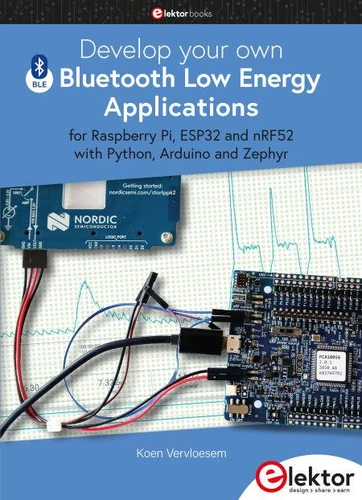Develop your own Bluetooth Low Energy Applications. For Raspberry Pi, ESP32 and nRF52 with Python, Arduino and Zephyr
Par :Formats :
Disponible dans votre compte client Decitre ou Furet du Nord dès validation de votre commande. Le format PDF est :
- Compatible avec une lecture sur My Vivlio (smartphone, tablette, ordinateur)
- Compatible avec une lecture sur liseuses Vivlio
- Pour les liseuses autres que Vivlio, vous devez utiliser le logiciel Adobe Digital Edition. Non compatible avec la lecture sur les liseuses Kindle, Remarkable et Sony
 , qui est-ce ?
, qui est-ce ?Notre partenaire de plateforme de lecture numérique où vous retrouverez l'ensemble de vos ebooks gratuitement
Pour en savoir plus sur nos ebooks, consultez notre aide en ligne ici
- Nombre de pages257
- FormatPDF
- ISBN978-3-89576-501-8
- EAN9783895765018
- Date de parution06/06/2022
- Protection num.Digital Watermarking
- Taille41 Mo
- Infos supplémentairespdf
- ÉditeurElektor
Résumé
Bluetooth Low Energy (BLE) radio chips are ubiquitous from Raspberry Pi to lightbulbs. BLE is an elaborate technology with a comprehensive specification, but the basics are quite accessible.
A progressive and systematic approach will lead you far in mastering this wireless communication technique, which is essential for working in low power scenarios.
In this book, you'll learn how to:
> Discover BLE devices in the neighborhood by listening to their advertisements.
> Create your own BLE devices advertising data. > Connect to BLE devices such as heart rate monitors and proximity reporters. > Create secure connections to BLE devices with encryption and authentication. > Understand BLE service and profile specifications and implement them. > Reverse engineer a BLE device with a proprietary implementation and control it with your own software.
> Make your BLE devices use as little power as possible. This book shows you the ropes of BLE programming with Python and the Bleak library on a Raspberry Pi or PC, with C++ and NimBLE-Arduino on Espressif's ESP32 development boards, and with C on one of the development boards supported by the Zephyr real-time operating system, such as Nordic Semiconductor's nRF52 boards. Starting with a very little amount of theory, you'll develop code right from the beginning.
After you've completed this book, you'll know enough to create your own BLE applications.
> Create your own BLE devices advertising data. > Connect to BLE devices such as heart rate monitors and proximity reporters. > Create secure connections to BLE devices with encryption and authentication. > Understand BLE service and profile specifications and implement them. > Reverse engineer a BLE device with a proprietary implementation and control it with your own software.
> Make your BLE devices use as little power as possible. This book shows you the ropes of BLE programming with Python and the Bleak library on a Raspberry Pi or PC, with C++ and NimBLE-Arduino on Espressif's ESP32 development boards, and with C on one of the development boards supported by the Zephyr real-time operating system, such as Nordic Semiconductor's nRF52 boards. Starting with a very little amount of theory, you'll develop code right from the beginning.
After you've completed this book, you'll know enough to create your own BLE applications.
Bluetooth Low Energy (BLE) radio chips are ubiquitous from Raspberry Pi to lightbulbs. BLE is an elaborate technology with a comprehensive specification, but the basics are quite accessible.
A progressive and systematic approach will lead you far in mastering this wireless communication technique, which is essential for working in low power scenarios.
In this book, you'll learn how to:
> Discover BLE devices in the neighborhood by listening to their advertisements.
> Create your own BLE devices advertising data. > Connect to BLE devices such as heart rate monitors and proximity reporters. > Create secure connections to BLE devices with encryption and authentication. > Understand BLE service and profile specifications and implement them. > Reverse engineer a BLE device with a proprietary implementation and control it with your own software.
> Make your BLE devices use as little power as possible. This book shows you the ropes of BLE programming with Python and the Bleak library on a Raspberry Pi or PC, with C++ and NimBLE-Arduino on Espressif's ESP32 development boards, and with C on one of the development boards supported by the Zephyr real-time operating system, such as Nordic Semiconductor's nRF52 boards. Starting with a very little amount of theory, you'll develop code right from the beginning.
After you've completed this book, you'll know enough to create your own BLE applications.
> Create your own BLE devices advertising data. > Connect to BLE devices such as heart rate monitors and proximity reporters. > Create secure connections to BLE devices with encryption and authentication. > Understand BLE service and profile specifications and implement them. > Reverse engineer a BLE device with a proprietary implementation and control it with your own software.
> Make your BLE devices use as little power as possible. This book shows you the ropes of BLE programming with Python and the Bleak library on a Raspberry Pi or PC, with C++ and NimBLE-Arduino on Espressif's ESP32 development boards, and with C on one of the development boards supported by the Zephyr real-time operating system, such as Nordic Semiconductor's nRF52 boards. Starting with a very little amount of theory, you'll develop code right from the beginning.
After you've completed this book, you'll know enough to create your own BLE applications.




